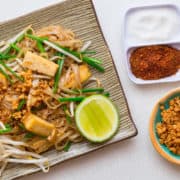Authentic Vegan Pad Thai ผัดไทย
Chances are you've had pad thai before and chances are it tasted good. Chances are also high that, if you had it outside of Thailand, it lacked in authenticity to some degree. As much as I avoid the word authentic in food discussion and the snobbishness (not to mention inaccuracy) it often suggests, here I mean its use to reference to some ingredients that have somehow been forgotten in the exported version of this Thai favourite. The two ingredients that are mostly forgotten are preserved turnip and Chinese chives. Spring onions can technically be substituted for the latter but will not offer the same flavour profile. Both of these ingredients can be sourced at a large East Asian grocer.
Servings: 2
Equipment
- Wok
Ingredients
- 120 grams dried thin sen lek flat rice noodles 3mm is my favourite, soaked in room temperature water for one hour
- 2 tablespoons palm sugar
- 2 tablespoons plus 1 teaspoon thin soy sauce
- ¼ teaspoon salt
- 1 tablespoon tamarind pulp
- 3-4 tablespoons hot water
- ¼ cup vegetable oil
- 150 grams of the firmest tofu you can find cut into ¼-½ inch cubes
- 20 grams 2 heaped tablespoons finely diced shallot
- 15 grams 1 tablespoon shredded preserved radish/turnip the sweet kind, not the salty one
- Handful bean sprouts
- Handful chinese chives cut into 1 inch lengths
- 1-2 tablespoons roasted chopped peanuts
- Slices of fresh lime
- Roasted chilli powder optional garnish
Instructions
- Soak the rice noodles in warm water for one hour. Boiling them to cook aids in their demise, so don’t be tempted unless you’re okay with soggy noodles. If you are, no judgement because sometimes I like them too.
- Make tamarind water by mashing the tamarind pulp and 45 millilitres of hot water in a small bowl. Fork and/or hands will suffice. Use the back of a wooden spoon or silicone spatula to press the pulp against a mesh strainer, sieving the thick-ish liquid into another small bowl. Be sure to scrape the thick goop from the bottom of the strainer. Discard the solids left in the strainer. Mix the palm sugar, soy sauce, and salt into the tamarind water.
- Once the noodles are soaked (the consistency will be bouncy with a little firmness, and they won’t taste like they’re ready to eat yet), heat a wok to medium high heat. Once hot, add the oil.
- Stir fry the tofu, shallot, and preserved radish for a few minutes, just until the tofu begins to colour. Add the noodles and the tamarind sauce, continuing to stir fry for about a minute. If the noodles don’t soften a little under the heat, toss a tablespoon of water in to aid in softening.
- Add most of the bean sprouts and Chinese chives, stir-frying just until wilted.
- Dish up, garnishing the noodles with the remaining sprouts and chives, plus a sprinkling of peanuts and toasted chilli powder. Serve with a slice of lime.
Notes
Recipe resources:
This is the type of shredded preserved turnip you want to use.
A lot of recipes I have seen on Western food blogs include Vietnamese chili sauce, the one that inaccurately represents Thai sriracha (pronounced see-rasha), in the ingredients. There is nothing wrong with this (do what tastes good to you), but know that in Thailand any heat in pad thai is derived from prik bon, or toasted chilli powder. Similarly fresh chillies are not commonly seen in this dish.
You would also not find plates of pad thai in Thailand garnished with fresh herbs (e.g. coriander, spring onion, mint, basil). Chunky vegetables are also virtually unseen, although there's nothing wrong with tossing some in if you must.
Oh, and finally, pad thai is eaten with a fork and spoon. That said, if you wish to hone your chopsticks skills then by all means go ahead.
